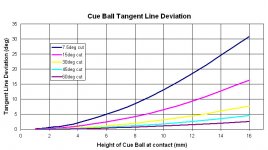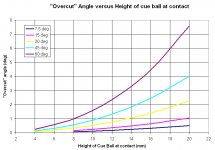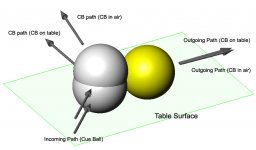1, Is the cue ball still on the cloth when it makes the first contact to the object ball when it has been striked by an elevated cue?
If the cue is still on the cloth when it contacts the first ball, it wont jump high enough to clear other balls and land in the middle of a cluster. When jumping into a cluster you are really taking the forward energy of the cue ball, and changing it's direction, thus when you clip an object ball, the cue will not be moving forward so fast, but it will gain some height. If you contact both the object ball and the table bed simultaneously it will only jump as high as it was jumping before the contact - which is probably not very much.
2, Will this result in a very slight over cut?
Yes - on the same logic as my earlier post. If you hit a ball in the air, the tangent line will shift over based on the actual contact point. This means if you aim it like you aren't jumping you will either over or under cut the ball (depending on whether you are cutting or reverse cutting the ball). If you find the actual contact point, then draw that tangent line in mid-air. Then take the reflection of that line onto the table bed, it will show the tangent to the actual path of the object ball.
3, Will the energy from the collision effect the carom angle greatly?
I don't think the carom angle will be different, except that as above, your actual tangent will not be what you think it is based on a 2D surface. The carom angle will hold true for the cue ball moving in 3D space above the table.
4, Why does the cue ball jump after a forced follow? after a 9-ball break?
This was answered already.


